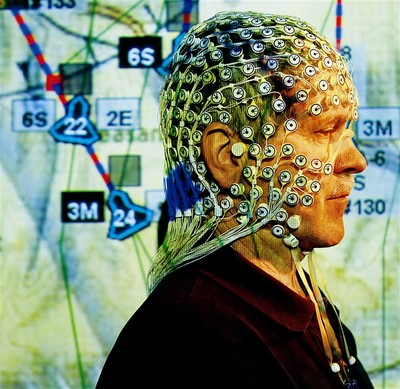“Augmented Cognition,” the Darpa program to build computer interfaces that adapt to their users’ brains, has officially run its course. But efforts to build mind-reading PCs continue throughout the military establishment. Augmented Cognition relies on the idea that people have more than one kind of working memory, and more than one kind of attention; there are separate slots in the mind for things written, things heard and things seen. By monitoring how taxed those areas of the brain are, it should be possible to change a computer’s display to compensate. If people are getting too much visual information, send them a text alert. If they reading too much at once, present some of the data visually — in a chart or map.

The Air Force has tapped Design Interactive, Inc. to build a battlefield command-and-control system that works along these lines. It’s supposed to use EEG and eye-tracking monitors to “assess the operator’s actual cognitive state.” That way, the system can play around with its “information display” to “avoid cognitive bottlenecks before they occur.” And that’s just the start. Eventually, the company wants the program to “anticipate future mission state and operator functional state ahead of time,” too.
This Air Force has also handed out a contract to Quantum Applied Science and Research, Inc. — that’s right, QUASAR for short — to perfect a mind-reading interface for squads of killer drones. Supervising all those armed, flying robots might be doable when things are relatively calm. But, in the heat of battle, it might be too much for one puny human mind to handle unassisted.
Darpa isn’t done with these technologies, either. The agency plans to spend $12 million next year on brain-science programs like Neurotechnology for Intelligence Analysts. It’s an AugCog-inspired effort to tap the firings of the subconscious mind to sort through satellite pictures quickly. Early tests have shown as much as a six-fold increase in the analysts’ efficiency, when the computer and the brain work together.
Photo: Jeff Corwin Photography, Boeing